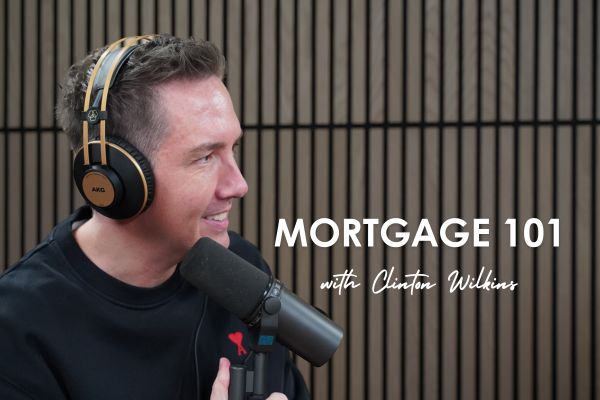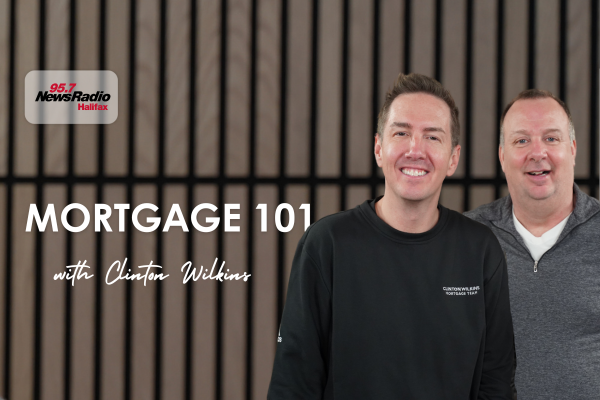Sandi Burns, Chief Credit Officer at Manulife Bank, joins Clinton and Todd to discuss her role in setting mortgage guidelines and managing the lending portfolio while highlighting Manulife's unique mortgage product.
Mortgage 101 – putting debt in the best financial vehicle with a refinance | April 2022 Part 3
In this episode of Mortgage 101 with Clinton Wilkins and Todd Veinotte, as heard on CityNews 95.7 and CityNews 101.1, the guys talk about putting debt in the best financial vehicle with a refinance. The two dive into other components of a refinance and answer these questions: What triggers an appraisal in a refinance; are refinances always 80 per cent of the market value; and what documents do I need for a refinance?
Mortgage 101 with Clinton Wilkins & Todd Veinotte: Putting debt in the best financial vehicle.
Don’t feel like watching the video? Check out the transcript below.
Transcript:
Refinance to pay off debts
Todd Veinotte: [00:00:00:01] Let’s talk about refinance. Not for everybody.
Clinton Wilkins: [00:00:03:05] It certainly is not for everyone, you know? I think a lot of households, their goal is to become mortgage free. And, you know, sometimes doing a refinance, Todd and pulling some equity out of the home can actually help you get mortgage free faster.
Todd Veinotte: [00:00:19:07] How so?
Clinton Wilkins: [00:00:19:23] Imagine.
Todd Veinotte: [00:00:20:19] How so?
Clinton Wilkins: [00:00:21:13] Actually, just talk to somebody today. They had $100,000 worth of unsecured debt, which they are currently paying $3,000 a month on, outside of their mortgage. Home worth $500,000. Mortgage owed less than $300,000. Buda boom buda bing, combine it all together into a new mortgage for $400,000. And guess what? We can cut the amortization in less than half.
Todd Veinotte: [00:00:51:16] Wow. So when you talk about $100,000 in unsecured debt, are you talking…
Clinton Wilkins: [00:00:57:00] Lines of credit. Credit card. Loans.
Todd Veinotte: [00:00:58:21] What type of interest rates would you be talking about?
Clinton Wilkins: [00:01:01:09] Pretty high.
Todd Veinotte: [00:01:03:04] Yeah?
Clinton Wilkins: [00:01:03:09] You know, I would say some of it would be 20 per cent. Some of it is, you know, around like seven, eight, nine per cent. Depends on kind of like what credit facility is. And, you know, on a really good unsecured line of credit, it’s usually even like around five per cent, Todd. So we’re talking anywhere from like five to 20 per cent, usually.
And these guys were hammering it down, you know, they were paying it. Lots of good household income, no problem with affording it. But it would take them a real, real long time. Like we’re talking, I don’t know about forever, but we’re talking like more than five years probably to get this unsecured debt paid off and they were in the middle of their term.
But guess what? They were in a variable rate mortgage and it was only going to cost them something like $1,500 to get out of their term early. They’re paying that much a month in interest.
Todd Veinotte: [00:01:56:19] Wow.
Clinton Wilkins: [00:01:58:04] So pretty shocking when you look at it. And sometimes you really don’t think about, you know, the mechanics of like what would a refinance look like. And some people think that when you refinance, you’re like, well, I’m going to start my mortgage over and I pay all the interest in the beginning. It really depends on what the amortization is. And not everyone who does a refi goes to 30 years or goes to 25 years.
Clinton Wilkins: [00:02:18:24] We can play with the amortization because essentially you’re a free agent when we’re doing a refi and we can make sure the amortization meets your needs, and the term meets your needs, and the mortgage amount meets your needs. Now, don’t get me wrong, Todd. Not everybody’s doing a refi to pay unsecured debt. That is not really what I want to say, that that’s what we do all the time. It’s not.
Refinances are versatile for many situations
People are doing refis right now to improve their properties. People are doing refis and maybe putting a collateral charge type product on it. Maybe with like a home equity line of credit, maybe different mortgage components, and they’re using some of those credit facilities for investment purposes. All right. That has to be a pretty savvy investor, but that is an option. And thirdly, people are doing refinances to pay out other debts. And, you know, everybody’s situation is a little bit different.
I can tell you in our office, we reached out to a bunch of our clients over the last month or two and basically talked to them. You know, you bought a home prior to January 2020 or March 2020. You have a lot of equity in your property. You are in a variable rate mortgage product. Maybe looking at a mid term refinance makes sense. Now, obviously, Todd, it doesn’t make sense for everyone.
We like to check-in with clients and their situation
Clinton Wilkins: [00:03:38:08] You know, maybe if you’ve had a change of your employment and maybe if we can’t confirm your income, that might be a problem. Maybe if there’s been maybe some credit challenges, maybe that doesn’t make sense. But for a lot of people, it does. And, you know, I almost regret, not even regret that’s the wrong word, but I was very proactive before the pandemic.
You know, we did a lot of annual reviews, a lot of check ins with our clients, and our team still does that. But I didn’t have the time to look at a client’s file and say, “okay, let’s look at this. Yeah, a refi does make sense,” because guess what? We were busy with purchases. You know, we didn’t have this, nice to do, let’s look and see. Does a term refinance work for you?
But now where we’ve had a chance to pause and breathe and kind of re-evaluate, you know, we’re in a situation that, you know, we’re certainly doing a lot of refis and the amount of transactions we’re doing, you know, it was about the same as previous years, but more and more transactions are refis and less maybe our purchases. And I think that’s just a, you know, a symptom of the amount of inventory that’s in the market.
Refinance for home renovations
Todd Veinotte: [00:04:50:19] So when somebody refinances and they want to put their own money into the house, I know this firsthand because I just went through this. But it’s not as though you’re paying a contractor on their behalf or anything like that. It’s not like a new purchase where you get, you simply, the deal closes, you get your money into your bank account, and you could do anything you want with that money, not to suggest that people should, but you need some discipline. That’s what I’m getting at.
Clinton Wilkins: [00:05:14:23] I would 100 per cent say you have discipline. If we do a refi and we’re paying out other debts, typically the payment goes directly to that creditor. Alright? So that’s normally the way it works. When we’re doing a refi, we’re pulling equity out for an improvement, we’re doing renovations, the money then goes to your bank account. And yeah, you do need to make some good decisions.
Putting debt in the best financial vehicle
You don’t want to go on vacation or maybe buy a new car with it. You know, I’m not really a big believer on doing a refi and paying out cars, because guess what? That asset’s depreciating. And you don’t want to pay that car over 10, 15, 20, 25, 30 years, and you’re always going to need a new car. But if there’s other debts that might have maybe initially been maybe some short term debts, but then they’ve turned into some long term borrowing, it is a lot cheaper to do a refi at a variable rate, let’s say two per cent. It’s a lot cheaper to do a refi at two per cent than it is having money sitting on a credit card at 20 per cent.
And it’s not that we are creating any new debt. I think it’s just putting the debt in the best financial vehicle to help you pay it off faster. And I often ask people, I’m like, “Okay, how much are you paying on these accounts? Like, I know what comes up on the credit bureau, but like, how much are you paying?” And they’re like, “Oh, I’m putting $400 on this one, and I’m putting $500 on that one, and that one’s $800 a month.” And I add it up and I’m like, “Wow, if you even increase your mortgage payment by $1,000 a month compared to what you were paying before, you’re going to be further ahead.” And we’re able to put a couple thousand dollars a month back into that household every month. It’s a no brainer.
What triggers an appraisal in a refinance?
Todd Veinotte: [00:06:58:12] When it comes to appraisal is that usually what might happen? Not always. It depends. How do you know, when does an appraisal get triggered?
Clinton Wilkins: [00:07:06:07] So some lenders have a low ratio valuation system. Some lenders use the Canadian Mortgage and Housing Corporation just access their data. So refis are not insured, they’re not insurable. They’re conventional like a standard mortgage.
But some lenders have access to the low ratio valuation system, so they can see what the postal code is, what the square footage is, and is the value is reported. Other lenders have access to First Canadian Title, which is an insurance company, and they have a valuation service.
And other lenders use a third party appraisal management company and they also do their own auto evaluation. And if the value is supported by kind of any of those methods, then you don’t need an appraisal.
There is a lot of sales data right now which is positive, but I think if we’re doing a refi and I always ask the customer like, “What do you think this house is going to sell for? You know your house better than I do. I’ve never been to it. You know what comparable homes in your neighbourhood are selling for. Or at least you know you’re keeping an eye. You have a kind of have a reasonable idea what it’s worth.”
Knowing the value of your home
Clinton Wilkins: [00:08:13:18] And I take the lead from the customer. It’s sometimes a Goldilocks, though. It can’t be too high and it can’t be too low. You know? It can’t be too hard. It can’t be too soft. And, like, that’s one thing that we certainly do take into consideration. And not every property can go through this low ratio valuation system.
You know, if it’s a multi unit, maybe that won’t work. If it’s in a more rural area, like the postal code is B0, maybe that won’t work, but we certainly try these low ratio valuation systems first and if the value supported cool, that saves you some money, saves me some time. Everybody’s happy, but not in every scenario is the value supported.
And if it’s not, then we do need a full appraisal and typically it’s at the client’s cost. Some lenders do promotions that are on right now where they’ll reimburse the borrower for the cost of the appraisal. I mean, not every lender, but some do. And we can refinance up to 80 per cent of that market value. And that market value is determined by the appraisal, if it’s required. So it’s a maximum of 80 per cent of what the appraisal value is.
Are refinances always 80 per cent of the market value?
Todd Veinotte: [00:09:18:04] Do you often recommend going straight to the 80 per cent? Or sometimes you say, look, you don’t need the 80 per cent or what type of guidance is there?
Clinton Wilkins: [00:09:25:17] Yeah, it really depends. Like I think one consideration obviously is income. People can only swing so much and we never want to put somebody in a worse position. And I think that’s one thing that we really kind of look at. We evaluate how much can these people afford.
Typically, the level of affordability is somewhere between four and four and one half times the household annual income. So, you know, they might have a home, and they might own it and have lots of equity in the property, but they can only maybe secure a mortgage at 65 per cent or 50 per cent, depending on what their income is.
So I think that’s a consideration. And in some cases on a refinance, we’ll put a collateral charge type product on the home. So maybe it has multiple different components under that global limit.
So for example, let’s say you own a $500,000 home and we’re doing a global limit up to $400,000. But you say, “Hey, Clinton, we really only want a mortgage for $200,000,” right? We would still likely do this type of product. But maybe if you can qualify and you can afford it, we may open up a home equity line of credit up to that 80 per cent mark just so you have the available credit. So if you do need to dip into that for renovations or if you do want to dip into that for investments or something like that, it’s set up.
It’s so much easier to get access to credit when you don’t need it, but when you do need it, that sometimes can be a challenge. The average refinance file, typically from the day we opened it to funding, 60 days is the normal. So if you need to buy something or if you’re like, “Hey, I’m buying a new car, but it’s a used car,” chances are it might be easier and cheaper to finance that on your home equity line of credit. Right now, HELOCs, most lenders, prime plus 50 basis points. You’re looking at a rate of 3.2 per cent and that certainly can be a lot lower than a loan on a used car.
What documents do I need for a refinance?
Todd Veinotte: [00:11:14:19] So somebody is looking at refinance, what are some preliminary things they can get already lined up before you even come and see you?
Clinton Wilkins: [00:11:19:13] You know, income documents are super, super important. You know, if you’re on a salary, that’s easy. If you have variable income, typically we’ll get your pay stub and a two years of your T4. We would want your 2021 annual mortgage statement and a recent property tax bill. So obviously income, property is really important. We would want to get a list of your assets and then through our underwriting platform, we would pull your credit, obviously with your consent. We would ingest all the liabilities into the file and then obviously make the plan that works best for you. And obviously, we would make recommendations.
Todd Veinotte: [00:11:53:23] We have another segment to go. What do you want to talk about? Any idea or am I putting you on the spot?
Clinton Wilkins: [00:11:57:00] Well, I mean, you’re always putting me on the spot, but I’m sure we’ll be talking a little bit more, maybe about first-time home buyers. And if you want to ask me some more questions about refinance, you know, I can talk about it all day long.
Todd Veinotte: [00:12:07:18] Alright. We’ll figure it out. We’ll be right back.
If you have any questions, get in touch with us at Clinton Wilkins Mortgage Team! You can call us at (902) 482-2770 or contact us here.


